Lab Safety Manual - UCLA - Environment, Health & Safety
Lab Safety Manual - UCLA - Environment, Health & Safety
Lab Safety Manual - UCLA - Environment, Health & Safety
You also want an ePaper? Increase the reach of your titles
YUMPU automatically turns print PDFs into web optimized ePapers that Google loves.
EH&S policy requires each laboratory to<br />
complete a “Hazard Assessment Tool” prior<br />
to beginning work and to provide annual<br />
updates thereafter. PPE can be selected<br />
based on this hazard assessment. The<br />
online Hazard Assessment Tool can be<br />
accessed at: http://lsm.ehs.ucla.edu.<br />
How to Use and Maintain PPE<br />
Personal protective equipment should be kept<br />
clean and stored in an area where it will not<br />
become contaminated. Personal protective<br />
equipment should be inspected prior to use to<br />
ensure it is in good condition. It should fit<br />
properly and be worn properly. If it becomes contaminated or damaged, it should be cleaned or<br />
repaired when possible, or discarded and replaced.<br />
For additional requirements and information on selection of PPE, see <strong>UCLA</strong> Policy 905<br />
(http://www.adminpolicies.ucla.edu/pdf/905.pdf and Appendix Q).<br />
Contaminated Clothing/PPE<br />
In cases where spills or splashes of hazardous chemicals on clothing or PPE occur, the clothing/PPE<br />
should immediately be removed and placed in a closed container that prevents release of the<br />
chemical. Heavily contaminated clothing/PPE resulting from an accidental spill should be disposed<br />
of as hazardous waste. Non-heavily contaminated laboratory coats should be cleaned and properly<br />
laundered, as appropriate. <strong>Lab</strong>oratory personnel should never take contaminated items home for<br />
cleaning or laundering. Persons or companies hired to clean contaminated items must be informed<br />
of potentially harmful effects of exposure to hazardous chemicals and must be provided with<br />
information to protect themselves.<br />
Respiratory Protection<br />
Typically, respiratory protection is not needed in a laboratory. Under most circumstances, safe work<br />
practices, small scale usage, and engineering controls (fume hoods, biosafety cabinets, and general<br />
ventilation) adequately protect laboratory workers from chemical and biological hazards. Under<br />
certain circumstances, however, respiratory protection may be needed. These can include:<br />
An accidental spill such as:<br />
o a chemical spill outside the fume hood<br />
o a spill of biohazardous material outside a biosafety cabinet<br />
Performance of an unusual operation that cannot be conducted under the fume hood or<br />
biosafety cabinet<br />
When weighing powdered chemicals or microbiological media outside a glove box or other<br />
protective enclosure. Disposable filtering face-piece respirators are generally recommended<br />
for nuisance dusts. If the chemicals are toxic, contact EH&S for additional evaluation<br />
When exposure monitoring indicates that exposures exist that cannot be controlled by<br />
engineering or administrative controls<br />
As required by a specific laboratory protocol or as defined by applicable regulations<br />
Chemical Hygiene Plan 4-7 January 2013
















